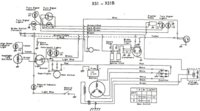Dakota_Lew
XS650 Agronomist
I have searched the forums but can't get quite what I am looking for so I need some confirmation and help on my thinking.
Problem: I have a single led indicator light (not stock, custom) that let's me know when my turn signals are on. So I have to wire each signal line to the same indicator light. (Schematic below) but if I do that it will make both lines hot instead of just the desired side.
Solution: I have two from what I can figure out. Wire In a relay of sorts to do what i want... But I was really wondering if I could find (which I haven't) one way diodes to solder them into the lines. The diodes may be just a mess of an idea...
Is my thinking correct or is there a better way? It just seems like a lot of work and there must be a better solution. Thanks guys.

Problem: I have a single led indicator light (not stock, custom) that let's me know when my turn signals are on. So I have to wire each signal line to the same indicator light. (Schematic below) but if I do that it will make both lines hot instead of just the desired side.
Solution: I have two from what I can figure out. Wire In a relay of sorts to do what i want... But I was really wondering if I could find (which I haven't) one way diodes to solder them into the lines. The diodes may be just a mess of an idea...
Is my thinking correct or is there a better way? It just seems like a lot of work and there must be a better solution. Thanks guys.

